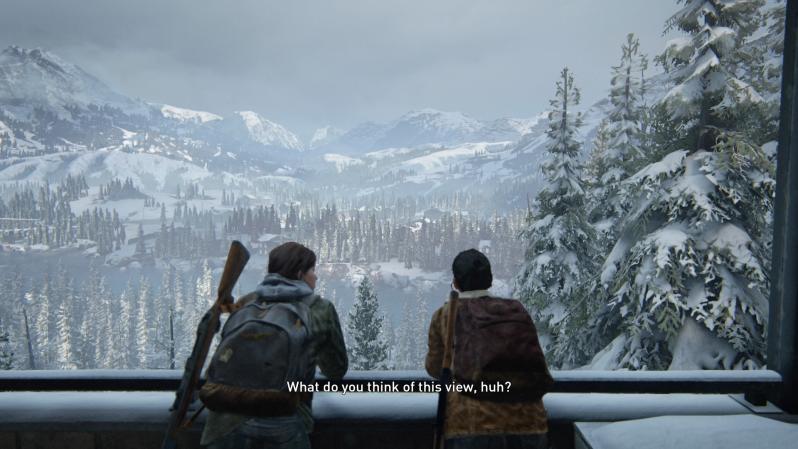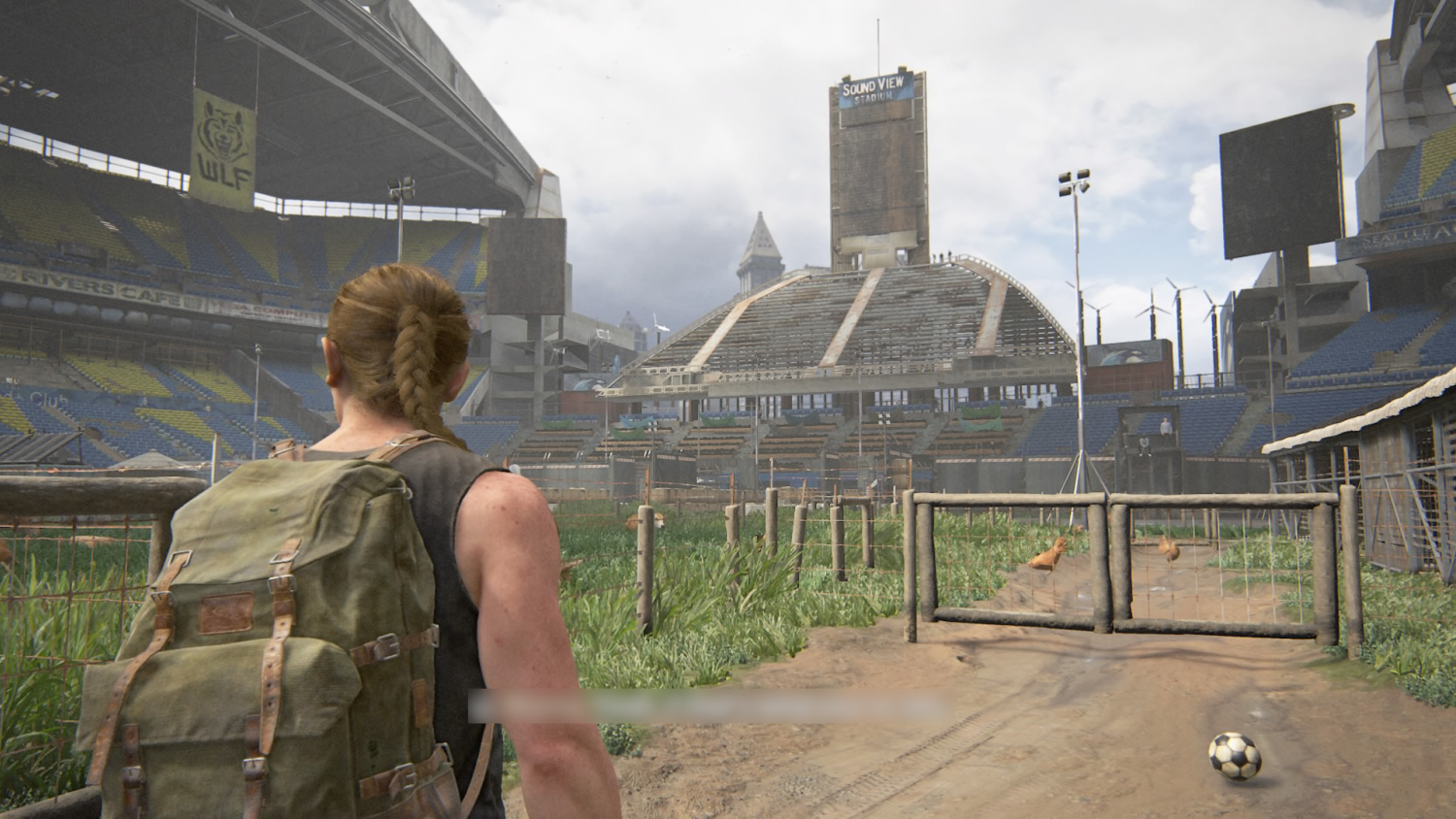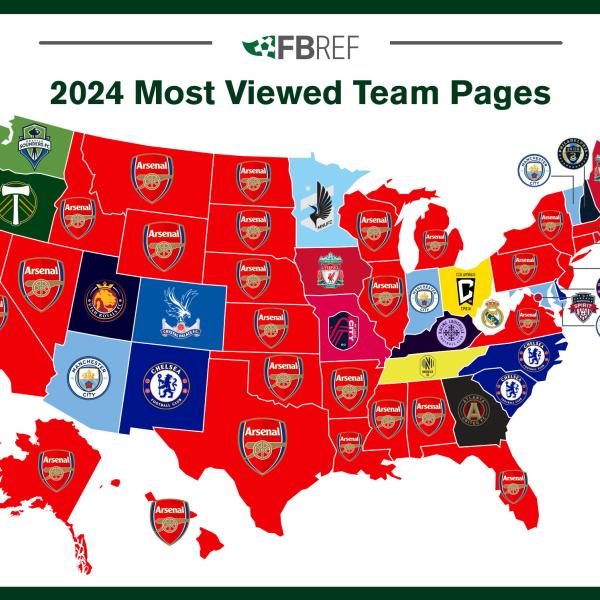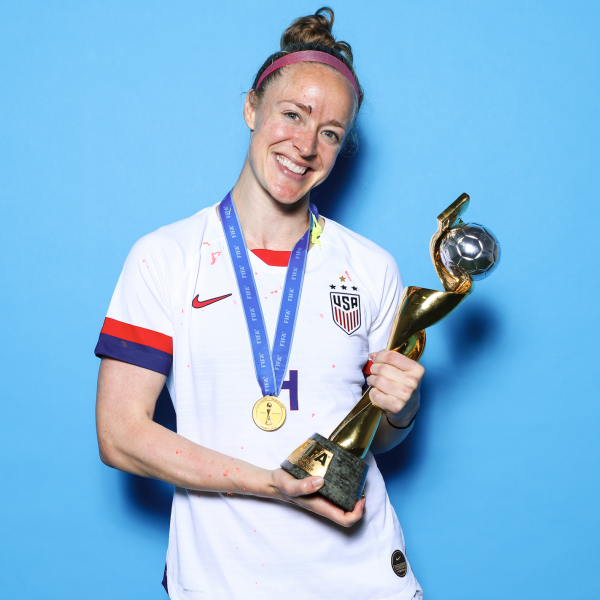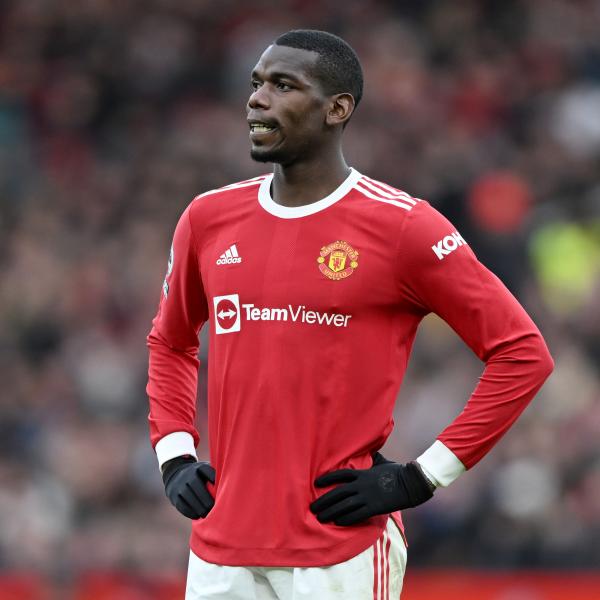Editor’s Note: This article contains story and gameplay spoilers for The Last of Us and The Last of Us Part II. We’ll provide additional warnings when we get to the bigger spoilers for each game.
By most measures, 2020 has been a really suck year for humanity; I don’t need to remind you of all the shit going on in the world. While the novel coronavirus has dramatically changed everyone’s lives, it’s always nice to remember that things could always be worse. Take, for instance, the world of The Last of Us, Naughty Dog’s video game masterpieces.
Over the last few months I played through The Last of Us Remastered and The Last of Us Part II, the former for the second time and the latter immediately upon its release in June. While playing, I took note of the game’s portrayal of soccer in the post-apocalyptic world.
While soccer was rarely overtly referenced throughout the two games, the environmental storytelling was more than enough to piece together what happened to soccer in the world of The Last of Us. Throughout the game, soccer is a reminder of loss in a game defined by loss — loss of loved ones, loss of hope and loss of a world we thought was permanent. It’s a chilling reminder of how lucky we are to live in a time where the beautiful game can be played and shared by all.
More than that, soccer in The Last of Us is an artistic choice threaded throughout Part I and II to enhance the themes of both games.
The World Of The Last Of Us
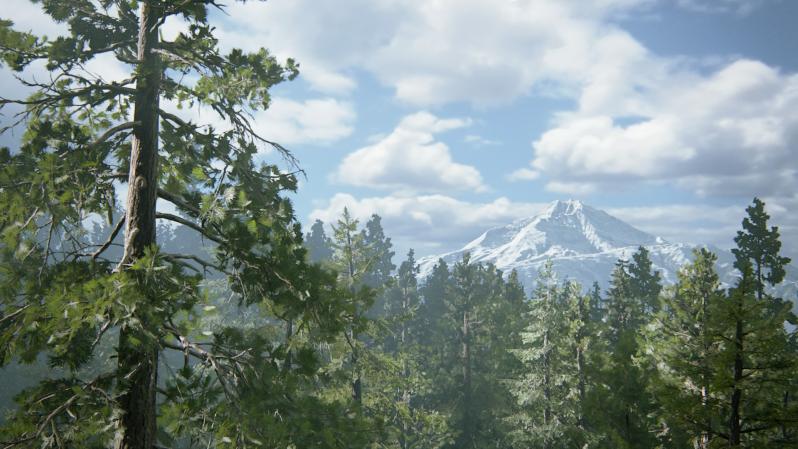
The world of The Last of Us is both beautiful and terrifying.
The Last of Us was originally released in 2013 on PlayStation 3. At the time, it was a groundbreaking video game that showed how the medium could be used to create art that defines a generation. The Remastered version game out a year later on PlayStation 4, slightly improving the already incredible graphics. The sequel, The Last of Us Part II, came out on June 19 and again redefined storytelling by forcing players to see the world through different lenses.
The game is set in a post-apocalyptic world after the outbreak of a disease spread through mutant Cordyceps fungi that turn anyone infected into zombie-like creatures who further spread the disease. While the game world is closer to science fiction than any real-world pandemic, the game focuses on the people living in the universe and their relationships with each other; the milieu is mere backdrop to the human drama that unfolds.
In the world of The Last of Us, the pandemic strikes humanity in October of 2013. The first game kicks off with the main character, Joel, facing early tragedy during the initial outbreak. The story (and the remainder of the game) then jumps ahead 20 years later to 2033, civilization having been mostly reduced to a few quarantine zones under military control and outlaw nomadic settlements. The Last of Us Part II mostly takes place about five years after the events of Part I (2038, give or take).
Soccer In The Last of Us
(Spoilers ahead for Part I.)
The Last of Us starts in 2013 just outside Austin, Texas. The player begins controlling Sarah, Joel’s daughter, who is 12. At the outset, we’re shown a normal life: Sarah’s room is filled with soccer posters, balls, trophies and laundry. Soccer is, from the very beginning, the anchor to the normal world we as players inhabit.
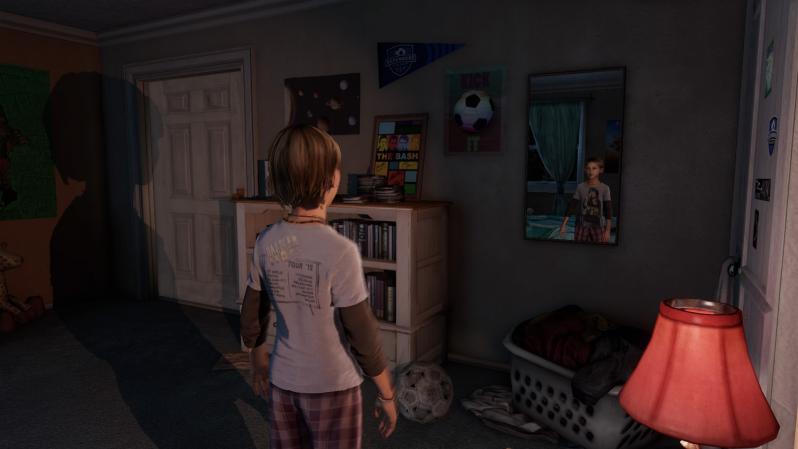
Sarah’s room is full of normal 12-year-old stuff, like music posters and soccer.
Sarah and Joel’s lives are quickly, irrevocably changed. As the Cordyceps fungus outbreak strikes Austin, Joel and his brother, Tommy, attempt to take Sarah to safety. While fleeing the madness enveloping their small suburb, Sarah is gunned down by a soldier and dies in Joel’s arms.
This is how the game begins — the first character you control, a soccer-loving tween, is murdered by a frantic man with a gun.
When the player next resumes control, Joel is following his smuggling partner Tess and the post-apocalyptic world begins to come into view. Soccer, like Sarah, is just a memory for Joel and the rest of the survivors.
While walking through the quarantine zone in Boston in the early moments of the game, Joel comes across a deflated soccer ball. It’s a first subtle reminder of his dead daughter, which becomes a theme throughout the first game.
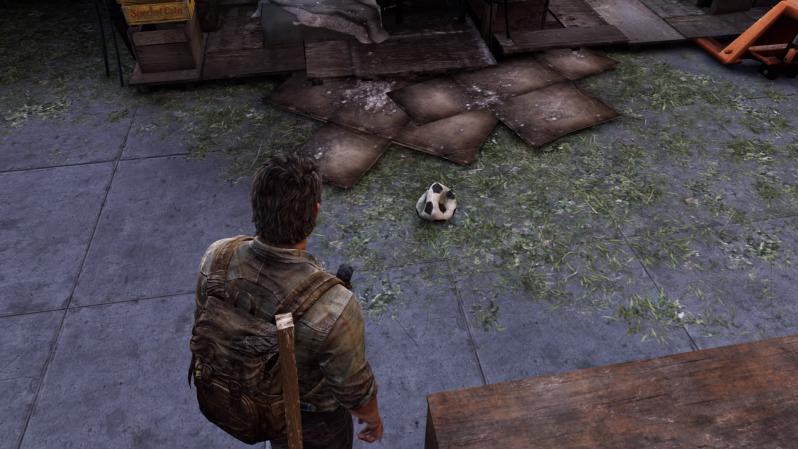
Soccer in the Boston quarantine zone.
The ball actually isn’t in bad shape, it’s just not aired up. If you wanted to read too much into it, you could suggest this represents Joel’s potential to overcome his daughter’s death.
As the story progresses, Joel is tasked with transporting a 14-year-old girl named Ellie across the country to find more Fireflies, a resistance group focused on finding a cure for Covid-19 the Cordyceps infection. Ellie, as it turns out, is immune to infection and could be humanity’s savior.
Joel and Ellie traverse the country, searching for Joel’s brother Tommy, a former Firefly himself who might know where to take Ellie after his initial contacts are killed by military police. Joel is reluctant to open up with Ellie, who isn’t much older than his daughter was when she died.
In Pittsburgh, Joel and Ellie meet up with two brothers, Henry, 25, and Sam, 13. There aren’t many kids around in the world of The Last of Us, especially outside of quarantine zones, so Sam and Ellie are immediately drawn to each other. During a trek through a sewer system, the foursome come across an abandoned camp that once housed children. The camp included a soccer goal and a ball that still had air in it, a clear sign soccer continues to be played in pockets even after the apocalypse, and a clear sign humanity still holds on to its past recreations. Notes (and dead bodies) left around the area tell the tale of a camp that was overrun by infected after someone carelessly left a door unlocked, as if to warn that survival leaves little time for amusements like soccer.
Immediately upon entering the abandoned camp, Sam and Ellie start playing soccer, naturally picking up the game. Despite having been born after the outbreak, both know what soccer is, either instinctively or having read or heard about it from other survivors.
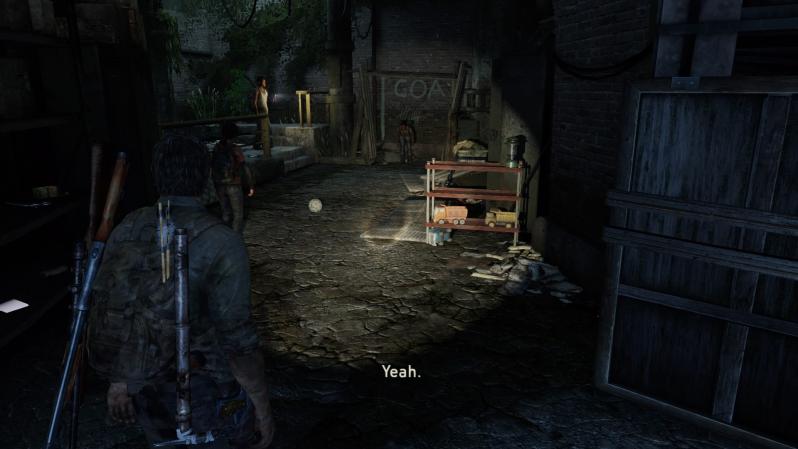
Ellie and Sam knew how to play soccer despite having been born after the outbreak.
Not long after, the foursome travels through abandoned homes in a suburb, including one that appears to have been inhabited by some young sports fans. While there is no sign of soccer in the house, there is a poster of a fictional football player (it looks like it’s an OU quarterback who probably took money from a local car dealership) and the fictional band The Bash, which was featured in Sarah’s room at the beginning of the game.
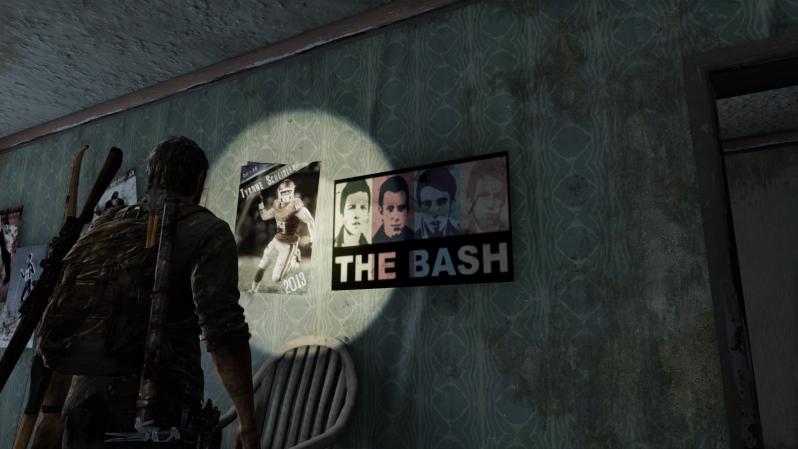
American football appears to have been mostly forgotten in the world of The Last of Us, aside from old posters like this.
As the story progresses, Joel and Ellie make their way to Jackson, Wyoming, where Tommy has joined a collective that’s managed to restore electricity via an old hydroelectric dam. Joel initially wants to let Tommy take Ellie the rest of the way to the Fireflies, but it’s an old photograph of Sarah celebrating a soccer win — and Ellie’s intervention — that convince Joel to continue on the pair’s journey.
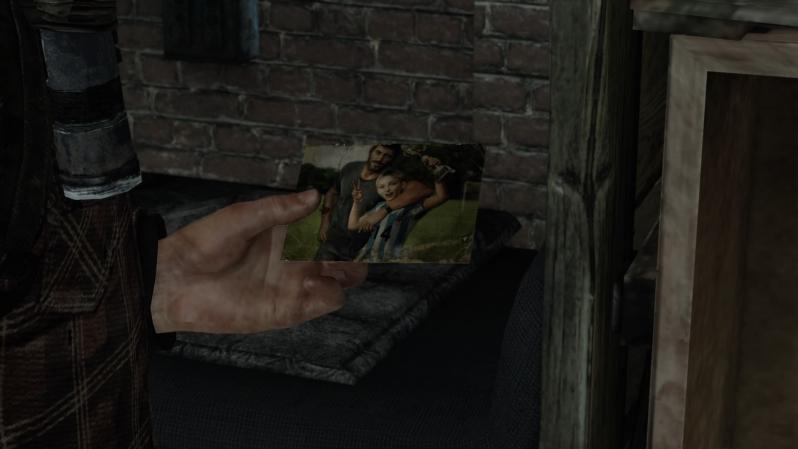
Tommy saved this photo of Sarah for Joel.
Joel and Ellie then make their way to the fictional University of Eastern Colorado where they hope to find Fireflies. They find only an abandoned enclave and hints the Fireflies moved to a hospital in Salt Lake City, Utah. Before they can head out, they’re attacked by bandits and Joel is severely wounded.
The player then controls Ellie in a search for supplies (in a post-release DLC). The search takes her to a nearby mall, where she happens upon a sporting goods store, which surprisingly has no soccer gear in it.
After killing a cabal of cannibals, Joel and Ellie make it to Utah. Ellie gives Joel the photo of Sarah and Joel on the pitch with a trophy; she had saved it after Joel showed no interest in holding on to the keepsake his brother had saved.
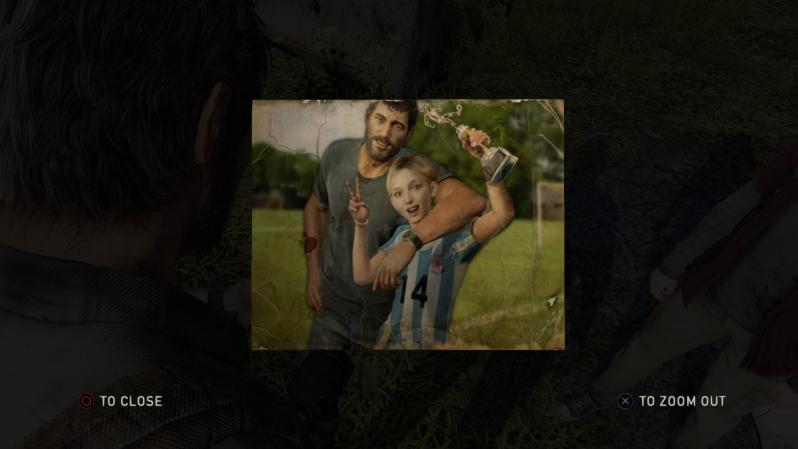
Joel and his daughter, Sarah, before the outbreak.
While the story had been building up to this scene, it’s clear at this moment that Joel now sees Ellie as his second chance at having a daughter, and it’s a soccer photo that brings it all home.
What follows is a dark, wicked ending, one of the more thought-provoking conclusions to any video game. (Major spoilers for the ending ahead.)
Joel and Ellie reach the Fireflies and there is a doctor who can make a cure using Ellie’s immunity. The only problem is the procedure would kill Ellie, requiring the doctor to remove Ellie’s brain. This is unacceptable to Joel, who finds a way to break into the lab, kill the doctors who are about to perform on an unconscious Ellie and break the teenager out of the city, killing as many Fireflies as he can along the way, including the group’s leader, Marlene.
Joel then takes Ellie back to Jackson, explaining that there were many others with immunity like her, but a cure couldn’t be created from it, lying as a father lies to a child to shield them from the truth. The game ends with Joel swearing it’s the truth, and players are left to question whether it was right for one man to save the life of a character we’ve all grown to adore but in doing so sacrifice the future of the human race.
If only Ellie hadn’t kept that soccer photo of Sarah.
Soccer In The Last Of Us Part II
(Major spoilers ahead for Part II.)
The Last of Us Part II takes place about five years after the events of the first game, though with flashbacks and flashforwards, the timeline is complex and varied as part of a unique narrative structure.
At the start of Part II, Joel is beaten and murdered by a new character named Abby, right in front of Ellie and Tommy’s eyes, setting both off on a quest for revenge. Before departing, Ellie stops by Joel’s old house, where she finds the old soccer photo of Joel and Sarah prominently displayed in a frame. Both are now dead, but they remain together, on a soccer field, in the memory of loved ones.

Father and daughter, forever framed in joy.
Ellie’s journey takes her and her new girlfriend, Dina, to Seattle in search of the WLF (Washington Liberation Front) to which Abby belongs. On their first day in Seattle, Ellie comes across a crusty old soccer ball in an abandoned home. Unlike the first soccer ball seen with Joel in the first game, this ball is well worn; not even air will revive it. Again, if you wanted to read too much into it, you could suggest this represents foreshadowing of Ellie’s inability to overcome Joel’s death.
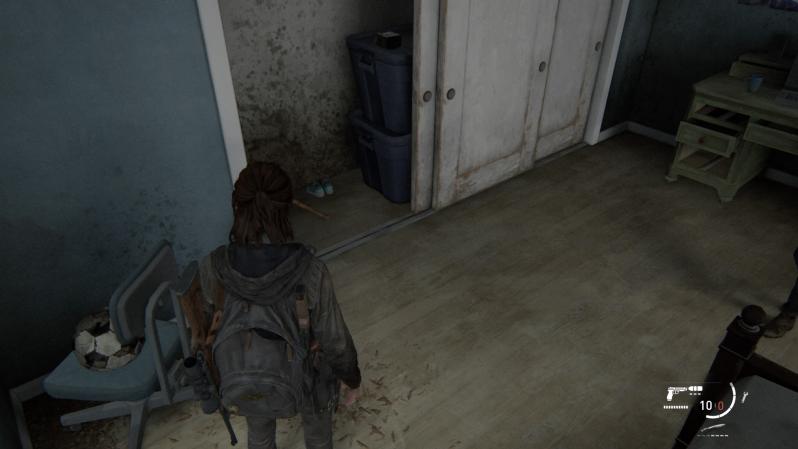
Is this unredeemable ball an omen?
On Day 2 in Seattle, Ellie finds another soccer ball among a pile of weights and kettle bells. While roughed up around the edges, it still fully retains its round shape. The ball appears to serve mostly as a cue to players that loot is in that corner.
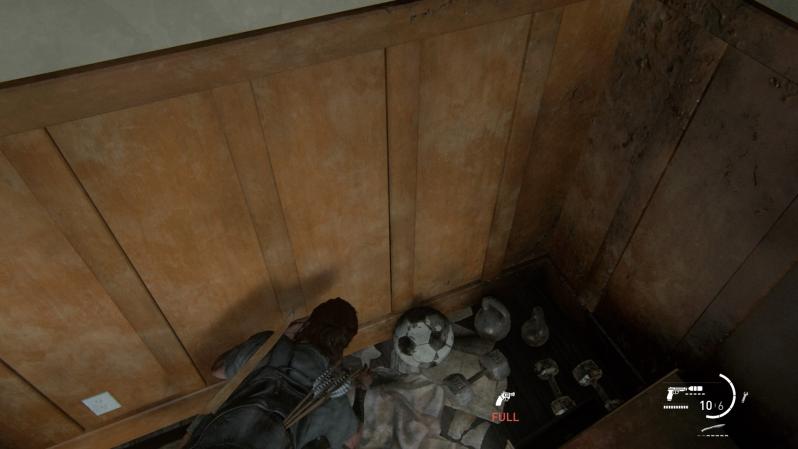
This ball appears to serve to show players precious ammo is nearby and keep Ellie focused on the task at hand.
And on Day 3, Ellie comes across two of the most well-preserved soccer balls we’ve seen yet in any Last of Us game. In a sporting goods store she sees a display that’s been completely stripped of all goods save for a couple water bottles and two soccer balls, looking almost untouched by time. By this point Ellie has been separated from her friends and the pair of balls could represent their lack of teamwork on this mission.
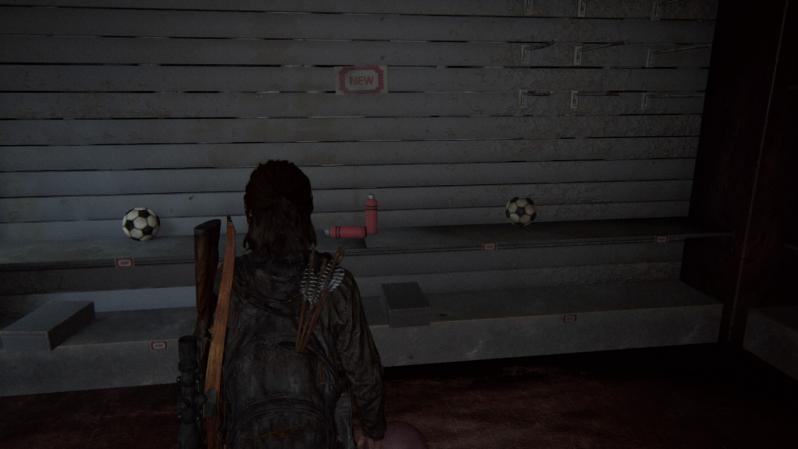
The two most pristine soccer balls we’ve seen yet.
This final ball of Ellie’s story comes as her descent into madness in her quest for revenge is nearly complete. The world is giving her stronger and stronger reminders of her daughter-like relationship with Joel, the man she’s trying to avenge. But even as she learns her girlfriend is pregnant, Ellie refuses to relent, ultimately resulting in the death of Jesse (Ellie’s good friend, Dina’s ex-boyfriend and the father of Dina’s baby).
After Day 3 in Seattle with Ellie, the game switches up and takes us back to Day 1 in Seattle — with Abby. The developers use a number of parallels in scenes to compare and contrast the stories of Ellie and Abby, and once again soccer plays a major role in environmental storytelling.
When players first take control of Abby — who we learn is the daughter of the doctor Joel killed to save Ellie, the only doctor who could’ve created a cure out of Ellie’s immunity — Abby is at the WLF home base. The base just happens to be carved out of Seattle’s biggest sporting venue, CenturyLink Field in real life but named Sound View Stadium in the game, a clear nod to the Seattle Sounders, who call the stadium home. Despite the different name, it’s quite clear the stadium was rendered to look like the real-life CenturyLink Field.
And if that wasn’t enough of a soccer cue, when Abby makes her way onto what used to be the pitch (it’s now been converted into farmland/pasture), a soccer ball rests in the dirt. This ball is in good shape, but it’s clear it’s been put to use.
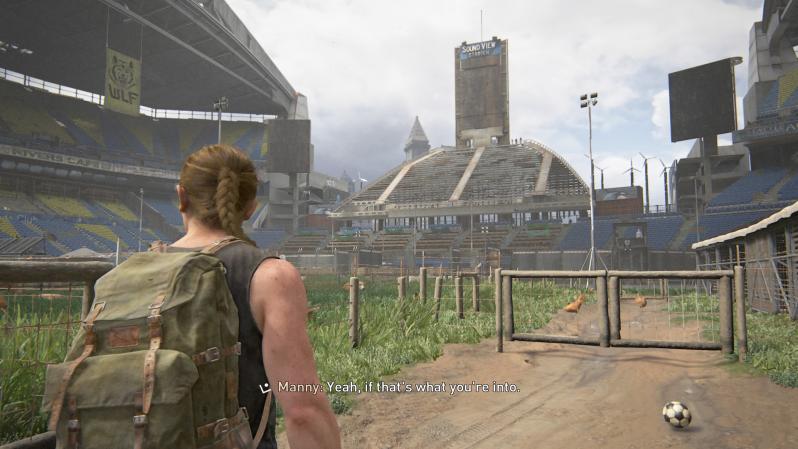
Sound View Stadium, home of the Seattle Sounders in The Last of Us Part II.
After the initial soccer reference in Abby’s story, soccer almost completely disappears as players see what Abby was doing while Ellie went on a rampage in Seattle, killing (often torturing) Abby’s friends. It shows there was a deliberate placement of soccer in the stories of Joel and Ellie, but not Abby.
The only other time we see soccer in Abby’s story is late in the game when she’s with Lev in Santa Barbara, well removed from the horror of Seattle, where Abby, Lev and Ellie lost loved ones. Abby went through all three days in Seattle (and her flashbacks) without seeing another ball. Only when she’s shown to have taken a big-sister role with Lev, a young boy who, with his sister, Yara, saved Abby from certain death, is soccer brought back into the game. With a small ball tucked away in a young child’s room, it’s as if the developers are showing us how Lev, a former potential enemy, has become like Ellie was to Joel in the first game, another parallel adding empathy for Abby and resentment for Ellie’s unquenchable thirst for revenge.
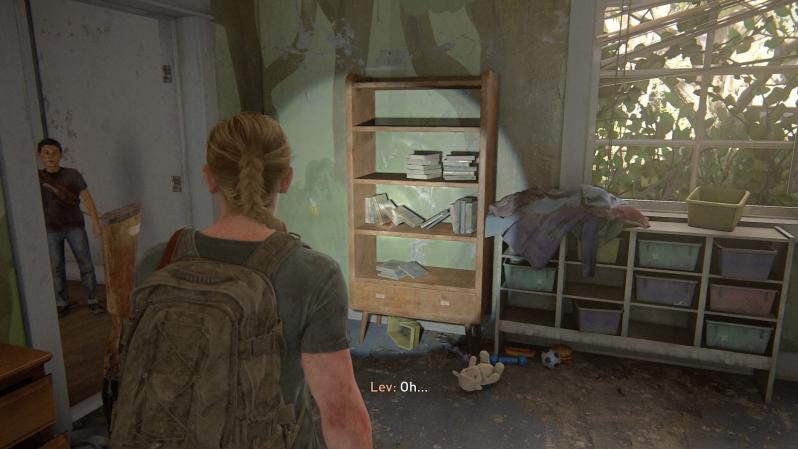
By the time the last ball is shown in Part II, Lev has become to Abby what Ellie was to Joel in Part I.
Shortly after the players come across this final soccer reference in The Last of Us, Abby and Lev are captured by slavers, setting up the culmination of Abby’s and Ellie’s stories. Ellie tracks down Abby in Santa Barbara and, after violently killing the slavers, frees Abby and Lev from a crucifixion-like death, only to force Abby to fight by threatening Lev’s life. It’s clear by now Ellie has lost everything in her pursuit of avenging Joel, right down to her humanity, not unlike Joel when he stripped Ellie of her life’s purpose by killing the Fireflies who could’ve used her immunity to create a cure.
The fight is brutal and unfair. Ellie is armed; Abby is defenseless and looks as though she hasn’t eaten anything in days. Abby bites off two of Ellie’s fingers but Ellie presses on, inches away from drowning Abby in the shallow sea. At the last moment, Ellie pulls off Abby (the developers said this was a late change and she was originally scripted to kill Abby). Ellie rediscovers her humanity and lets Abby live, just as Abby allowed Ellie to live twice before (in Jackson and in Seattle).
Ellie returns to Wyoming to find Dina and the baby are gone. Without all five fingers, she can no longer play the guitar Joel taught her to play. She thus heads off on her own, having lost all the friend she made along the way.
The Meaning Soccer In The Last Of Us
Throughout The Last of Us Parts I and II, soccer serves a dual purpose. On the surface, it represents a reminder of the world that was lost to the Cordyceps infection pandemic. On a deeper level, it symbolizes connection and love, first with Joel’s memories of his daughter, later with his relationship to Ellie, who becomes like a daughter, and finally with Abby’s adoption of Lev as a younger brother.
The world of The Last of Us shows soccer would not die in the apocalypse. Humans always look for recreation and there are few simpler, purer forms of recreation than the beautiful game. The consistent references to soccer come almost in the place of other sports. There are few references to basketball, American football and baseball, the latter mostly through characters finding baseball bats to use as weapons. The iconic giraffe scene in Part I — a brief respite of beauty and innocence amid unspeakable horrors — takes place on a baseball field; the American pastime is essentially ignored to instead focus on the natural beauty that has overtaken Salt Lake City in the absence of humanity.
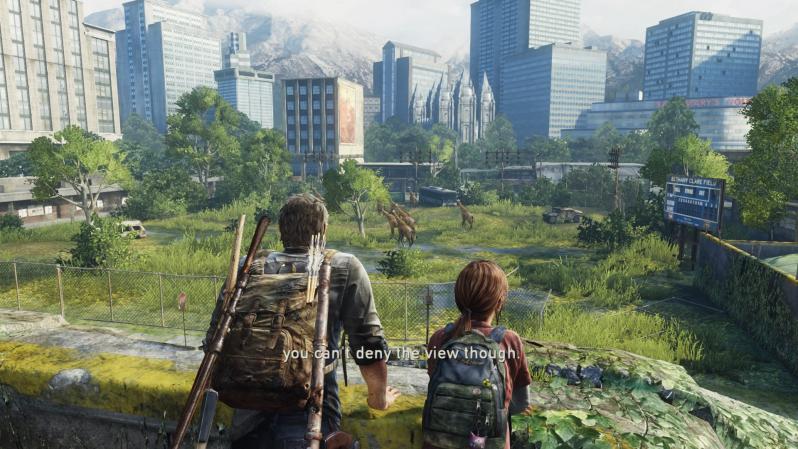
The unforgettable giraffe scene in Part I took place on a baseball field.
Soccer remains throughout the game the strongest link to the world before the outbreak. It’s soccer, not basketball, football or baseball, that reminds characters of the lives they had before the outbreak, or in the case of younger characters, the lives they never even got to experience.
By linking Sarah, Joel’s daughter, so intrinsically to soccer at the outset, The Last of Us creates a thread throughout both games as a metaphor for the bonds of love and friendship.
When Ellie finds a friend in a desolate world, they play soccer together.
When Joel wants to abandon Ellie, it’s a soccer photo that keeps them together.
When Ellie descends to her most basic instincts on her hunt for revenge, it’s soccer that appears as a foil to her failure to recognize what matters most.
When Abby accepts Lev as a part of her new family, soccer appears to again drive home the similarities in the relationships of Sarah, Joel and Ellie.
Additionally, soccer enhances the themes of both games.
In The Last of Us, the overarching theme is of the father-daughter bond between Joel and Ellie. Soccer serves as a reference point to the daughter Joel lost and the one he gains.
In The Last of Us Part II, the much darker theme of revenge is driven home by parallels between the stories Abby and Ellie, who both encounter soccer on their journeys.
All of this combines with the somewhat overt message from both games about humanity’s penchant for tribalism, one that can be viewed as a statement on the world in which we live today. In both games, players are confronted with enemies who appear relentlessly evil, whether it’s Hunters, WLFs, Scars or even Ellie. The developers make it clear through environmental storytelling and, in the latter parts of Part II, as the primary story arc, that everyone encountered in the game is just trying to do their best to survive. One group’s evil invader is another group’s foraging savior.
The way the game points out tribalism and its harmful effects on humanity could be seen as an allegory to modern day tribalism, as people around the world insulate themselves in echo chambers, hating anything and everything from those of another country, creed or political affiliation. To extend the metaphor to soccer, it could be seen as calling out the absurd tribalism between sports teams, where ultras often resort to violence against fans of another team for no reason other than the club they support.
Whether it’s the world of The Last of Us or 2020, everyone’s just trying to do their best to live their lives, and The Last of Us Parts I and II serve to remind players of this fact. And soccer is there every step of the way.
